Detailed Land Use Classification in a Rare Earth Mining Area Using Hyperspectral Remote Sensing Data for Sustainable Agricultural Development
Abstract
:1. Introduction
2. Data and Methodology
2.1. Overview of the Study Area
2.2. Data Sources and Pre-Processing
2.3. Classification System and Sample Point Selection
2.4. Research Method
2.4.1. Feature Declaration
2.4.2. Feature Optimization Methods
2.4.3. Importance Ranking of Features
2.4.4. Land Use Classification
2.4.5. Accuracy Verification
3. Results
3.1. Feature Optimization Results
3.1.1. Determination of Spectral Features
3.1.2. Determination of Vegetation Features
3.1.3. Determination of Red Edge Features
3.1.4. Determination of Texture Features

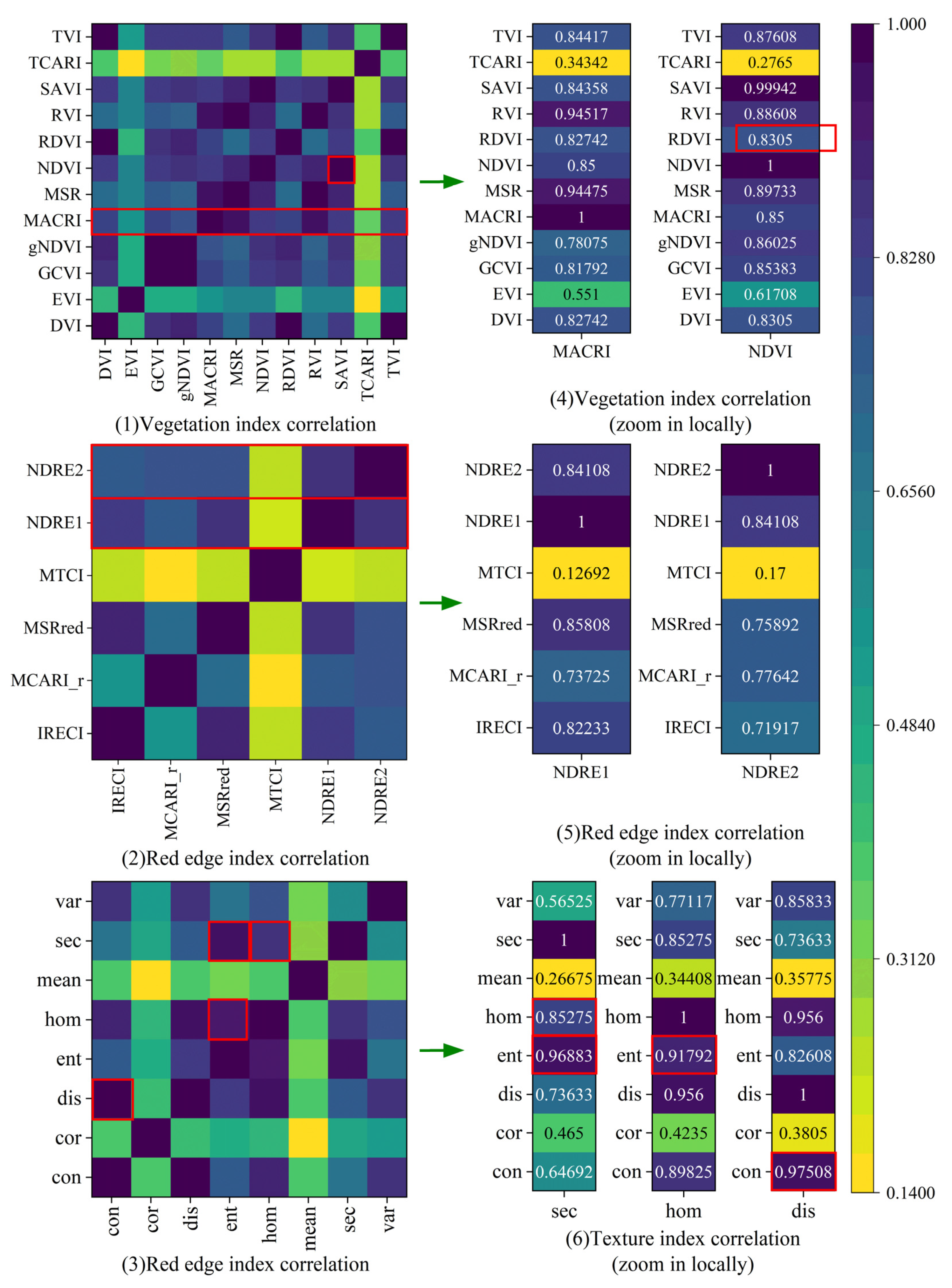
3.2. Importance Ranking of Characteristic Variables
3.3. Accuracy Evaluation of Land Use Classification in Mining Area
4. Discussion
5. Conclusions
Author Contributions
Funding
Institutional Review Board Statement
Informed Consent Statement
Data Availability Statement
Conflicts of Interest
References
- Shi, X.Y.; Chen, H.W. Study on the pollution path and remediation of ionized rare earth ores in waste pond leaching reactor. Chin. J. Rare Earth Sci. 2019, 37, 409–417. (In Chinese) [Google Scholar]
- Zou, G.L.; Wu, Y.D.; Cai, S.J. Effect of ionic rare earth leaching process on resources and Environment. Nonferrous Met. Sci. Eng. 2014, 5, 100–106. (In Chinese) [Google Scholar]
- Li, Y.; Li, H.; Xu, F. Spatiotemporal changes in desertified land in rare earth mining areas under different disturbance conditions. Environ. Sci. Pollut. Res. 2021, 28, 30323–30334. [Google Scholar] [CrossRef]
- Zhang, Y.H.; Zhao, X. Land-Use and Land-Cover Change Detection Using Dynamic Time Warping–Based Time Series Clustering Method. Can. J. Remote Sens. 2020, 46, 67–83. [Google Scholar] [CrossRef]
- Xiao, Y.; Jiang, Q.G.; Wang, B.; Li, Y.H.; Liu, S.; Cui, C. Object-oriented land use classification based on mixed feature selection of Relief F and PSO. Trans. Chin. Soc. Agric. Eng. 2016, 32, 211–216. (In Chinese) [Google Scholar]
- Zhang, Z.M.; Liu, B.; Guan, X. Land Use Type Change in the Upper Yellow River Basin Coal Mining Area and Its Impact on Carbon Sequestration Services. Environ. Sci. Res. 2024, 37. (In Chinese) [Google Scholar] [CrossRef]
- Xu, J.X.; Chen, C.; Zhou, S.T.; Hu, W.M.; Zhang, W. Land use classification in mine-agriculture compound area based on multi-feature random forest: A case study of Peixian. Front. Sustain. Food Syst. 2024, 7, 1335292. [Google Scholar] [CrossRef]
- Zheng, Y.; Wang, Y.; Liu, Y. Vegetation classification and recognition of mountain meadow based on seasonal characteristics of hyperspectral data. Spectrosc. Spectr. Anal. 2022, 42, 1939–1947. (In Chinese) [Google Scholar]
- Tu, C.R.; Li, P.; Li, Z.H.; Wang, H.J.; Yin, S.W.; Li, D.H.; Zhu, Q.T.; Chang, M.X.; Liu, J.; Wang, G.Y. Synergetic Classification of Coastal Wetlands over the Yellow River Delta with GF-3 Full-Polarization SAR and Zhuhai-1 OHS Hyperspectral Remote Sensing. Remote Sens. 2021, 13, 4444. [Google Scholar] [CrossRef]
- Xing, F.; An, R.; Guo, X.L.; Shen, X.J.; Soubry, I.; Wang, B.L.; Mu, Y.M.; Huang, X.L. Mapping Alpine Grassland Fraction Coverage Using Zhuhai-1 OHS Imagery in the Three River Headwaters Region, China. Remote Sens. 2023, 15, 2289. [Google Scholar] [CrossRef]
- Qin, P.; Cai, Y.L.; Wang, X.L. Small Waterbody Extraction With Improved U-Net Using Zhuhai-1 Hyperspectral Remote Sensing Images. IEEE Geosci. Remote Sens. Lett. 2022, 19, 1–5. [Google Scholar] [CrossRef]
- Zhou, G.L.; Ni, Z.Y.; Zhao, Y.B.; Luan, J.W. Identification of Bamboo Species Based on Extreme Gradient Boosting (XGBoost) Using Zhuhai-1 Orbita Hyperspectral Remote Sensing Imagery. Sensors 2022, 22, 5434. [Google Scholar] [CrossRef]
- Cui, B.G.; Li, X.H.; Wu, J.; Ren, G.B.; Lu, Y. Tiny-Scene Embedding Network for Coastal Wetland Mapping Using Zhuhai-1 Hyperspectral Images. IEEE Geosci. Remote Sens. Lett. 2022, 19, 1–5. [Google Scholar] [CrossRef]
- Mo, Y.; Zhong, R.F.; Cao, S.S. Orbita hyperspectral satellite image for land cover classification using random forest classifier. J. Appl. Remote Sens. 2021, 15, 014519. [Google Scholar] [CrossRef]
- Wang, Z.H.; Zhao, Z.; Yin, C.L. Fine Crop Classification Based on UAV Hyperspectral Images and Random Forest. ISPRS Int. J. Geo-Inf. 2022, 11, 252. [Google Scholar] [CrossRef]
- Somnath, P.; Nikhil, R.D.; Mukunda, D.B.; Bimal, K.B.; Jadunandan, D. Species-level classification of mangrove forest using AVIRIS-NG hyperspectral imagery. Remote Sens. Lett. 2023, 14, 522–533. [Google Scholar]
- Qin, H.M.; Zhou, W.Q.; Yao, Y.; Yao, W.M. Individual tree segmentation and tree species classification in subtropical broadleaf forests using UAV-based LiDAR, hyperspectral, and ultrahigh-resolution RGB data. Remote Sens. Environ. 2022, 280, 113143. [Google Scholar] [CrossRef]
- Liu, J.F.; Hu, X. Overall Planning of Mineral Resources in Jiangxi Province 2008–2015; Jiangxi Science and Technology Press: Nanchang, China, 2011. [Google Scholar]
- Zhuhai Orbita Aerospace Micro Technology Co., Ltd. Available online: https://www.myorbita.net/index.aspx (accessed on 21 February 2024).
- BIGMAP. Available online: http://www.bigemap.com/ (accessed on 21 February 2024).
- Yu, W.W.; Zhao, P.; Xu, K.J.; Zhao, Y.J.; Shen, P.J.; Ma, J.J. Evaluation of red-edge features for identifying subtropical tree species based on Sentinel-2 and Gaofen-6 time series. Int. J. Remote Sens. 2022, 43, 3003–3027. [Google Scholar] [CrossRef]
- Guo, Y.C.; Ren, H.R. Remote sensing monitoring of maize and paddy rice planting area using GF-6 WFV red edge features. Comput. Electron. Agric. 2023, 207, 107714. [Google Scholar] [CrossRef]
- Pei, H.; Sun, T.J.; Wang, X.Y. Object-oriented land use/cover classification based on Landsat 8 OLI image texture. Trans. Chin. Soc. Agric. Eng. 2018, 34, 248–255. (In Chinese) [Google Scholar]
- Wang, L.J.; Kong, Y.R.; Yang, X.D.; Xu, Y.; Liang, L.; Wang, S.G. Land use classification of agricultural areas based on feature optimization random forest algorithm. Trans. Chin. Soc. Agric. Eng. 2020, 36, 244–250. (In Chinese) [Google Scholar]
- Wang, C.X.; Ma, N.; Ming, Y.F.; Wang, Q.; Xia, J.F. Classification of hyperspectral imagery with a 3D convolutional neural network and J-M distance. Adv. Space Res. 2019, 64, 886–899. [Google Scholar] [CrossRef]
- Sun, Z.P.; Shen, W.M.; Wei, B.; Liu, X.M.; Su, W.; Zhang, C.; Yang, J.Y. Object-oriented land cover classification using HJ-1 remote sensing imagery. Sci. China Ser. D Earth Sci. 2010, 53, 34–44. [Google Scholar] [CrossRef]
- Zhang, X.; Chen, B.Z.; Zhao, H.; Fan, H.D.; Zhu, D. Soil Moisture Retrieval over a Semiarid Area by Means of PCA Dimensionality Reduction. Can. J. Remote Sens. 2016, 42, 136–144. [Google Scholar] [CrossRef]
- Wang, X.F.; Lu, C.H.; Li, J.X.; Liu, J. Generalized cosine two-dimensional principal component analysis. Acta Autom. Sin. 2022, 48, 2836–2851. (In Chinese) [Google Scholar]
- Jason, Y.; Du, X.R. An enhanced water index in extracting water bodies from Landsat TM imagery. Ann. GIS 2017, 23, 141–148. [Google Scholar]
- Xiang, S.Y.; Xu, Z.H.; Zhang, Y.W.; Zhang, Q.; Zhou, X.; Yu, H.; Li, B.; Li, Y.F. Construction and application of ReliEF-RFE feature Selection Algorithm for hyperspectral image classification. Spectrosc. Spectr. Anal. 2022, 42, 3283–3290. (In Chinese) [Google Scholar]
- Yu, X. A feature selection approach based on NSGA-II with ReliefF. Appl. Soft Comput. 2023, 134, 109987. [Google Scholar]
- Li, H.K.; Wang, L.J.; Xiao, S.S. Land use random forest classification in southern hilly region based on multi-source data. Trans. Chin. Soc. Agric. Eng. 2021, 37, 244–251. (In Chinese) [Google Scholar]
- Sabat-Tomala, A.; Raczko, E.; Zagajewski, B. Comparison of support vector machine and random forest algorithms for invasive and expansive species classification using airborne hyperspectral data. Remote Sens. 2020, 12, 516. [Google Scholar] [CrossRef]
- Xi, Y.; Ren, C.; Wang, Z.; Wei, S.; Bai, J.; Zhang, B.; Xiang, H.; Chen, L. Mapping tree species composition using OHS-1 hyperspectral data and deep learning algorithms in Changbai mountains, Northeast China. Forests 2019, 10, 818. [Google Scholar] [CrossRef]
- Meng, Q.Y.; Dong, H.; Qin, Q.M.; Wang, J.L.; Zhao, J.H. A plant cover index MTCARI for monitoring vegetation chlorophyll content based on hyperspectral remote sensing. Spectrosc. Spectr. Anal. 2012, 8, 2218–2222. (In Chinese) [Google Scholar]
- Kodimalar, T.; Vidhya, R.; Eswar, R. Land surface emissivity retrieval from multiple vegetation indices: A comparative study over India. Remote Sens. Lett. 2020, 11, 176–185. [Google Scholar] [CrossRef]
- Tian, X.Y.; Zang, Y.H.; Liu, R.; Wei, J.J. Study on multi-temporal Sentinel-2 large-scale winter wheat extraction considering vegetation red edge information. J. Remote Sens. 2022, 26, 1988–2000. (In Chinese) [Google Scholar]
- Wu, J.Y.; Liu, X.L.; Bo, Y.C.; Shi, Z.T.; Fu, Z. Identification of plastic greenhouses based on GF-2 data combined with multi-texture features. Trans. Chin. Soc. Agric. Eng. 2019, 35, 173–183. (In Chinese) [Google Scholar]
- Liu, J.; Wang, L.; Teng, F.; Yang, L.; Gao, J.; Yao, B.; Yang, F. Impact of red-edge waveband of RapidEye satellite on estimation accuracy of crop planting area. Nongye Gongcheng Xuebao/Trans. Chin. Soc. Agric. Eng. 2016, 32, 140–148. [Google Scholar]
- Hong, D.F.; Wu, X.; Ghamisi, P.; Chanussot, J.; Yokoya, N.; Zhu, X.X. Invariant Attribute Profiles: A Spatial-Frequency Joint Feature Extractor for Hyperspectral Image Classification. IEEE Trans. Geosci. Remote Sens. 2020, 58, 3791–3808. [Google Scholar] [CrossRef]
- Zhao, P.; Han, J.C.; Wang, C.K. Classification of wood species by hyperspectral microscopic imaging based on I-BGLAM texture and spectral fusion. Spectrosc. Spectr. Anal. 2021, 41, 599–605. (In Chinese) [Google Scholar]
- Zhang, C.Y.; Li, F.Y.; Li, J.; Xing, J.J.; Yang, J.Z.; Guo, J.T.; Du, S.H. Land use classification of open pit coal mine based on DeepLabv3+ and GF-2 high-resolution images. Coal Geol. Explor. 2022, 50, 94–103. (In Chinese) [Google Scholar]
- Rashedul, I.; Boshir, A.; Ali, H. Feature reduction of hyperspectral image for classification. J. Spat. Sci. 2022, 67, 331–335. [Google Scholar]
- Masoud, M.; Bahram, S.; Fariba, M. The First Wetland Inventory Map of Newfoundland at a Spatial Resolution of 10 m Using Sentinel-1 and Sentinel-2 Data on the Google Earth Engine Cloud Computing Platform. Remote Sens. 2019, 11, 43. [Google Scholar]
- Islam, M.R.; Siddiqa, A.; Ibn, A.M.; Uddin, M.P.; Ulhaq, A. Hyperspectral Image Classification via Information Theoretic Dimension Reduction. Remote Sens. 2023, 15, 1147. [Google Scholar] [CrossRef]
- Hao, Y.F.; Man, W.D.; Wang, J.H.; Liu, M.Y.; Zhang, K. Wetland information extraction based on Relief-F algorithm and decision tree method. J. Liaoning Tech. Univ. (Nat. Sci. Ed.) 2021, 40, 225–233. (In Chinese) [Google Scholar]
- Xie, S.Y.; Fu, B.L.; Li, Y.; Liu, Z.L.; Zuo, P.P.; Lan, F.W.; He, H.C.; Fan, D.L. Research on classification method of swamp wetland in Honghe National Nature Reserve based on multi-dimensional remote sensing image. Wetl. Sci. 2021, 19, 1–16. (In Chinese) [Google Scholar]

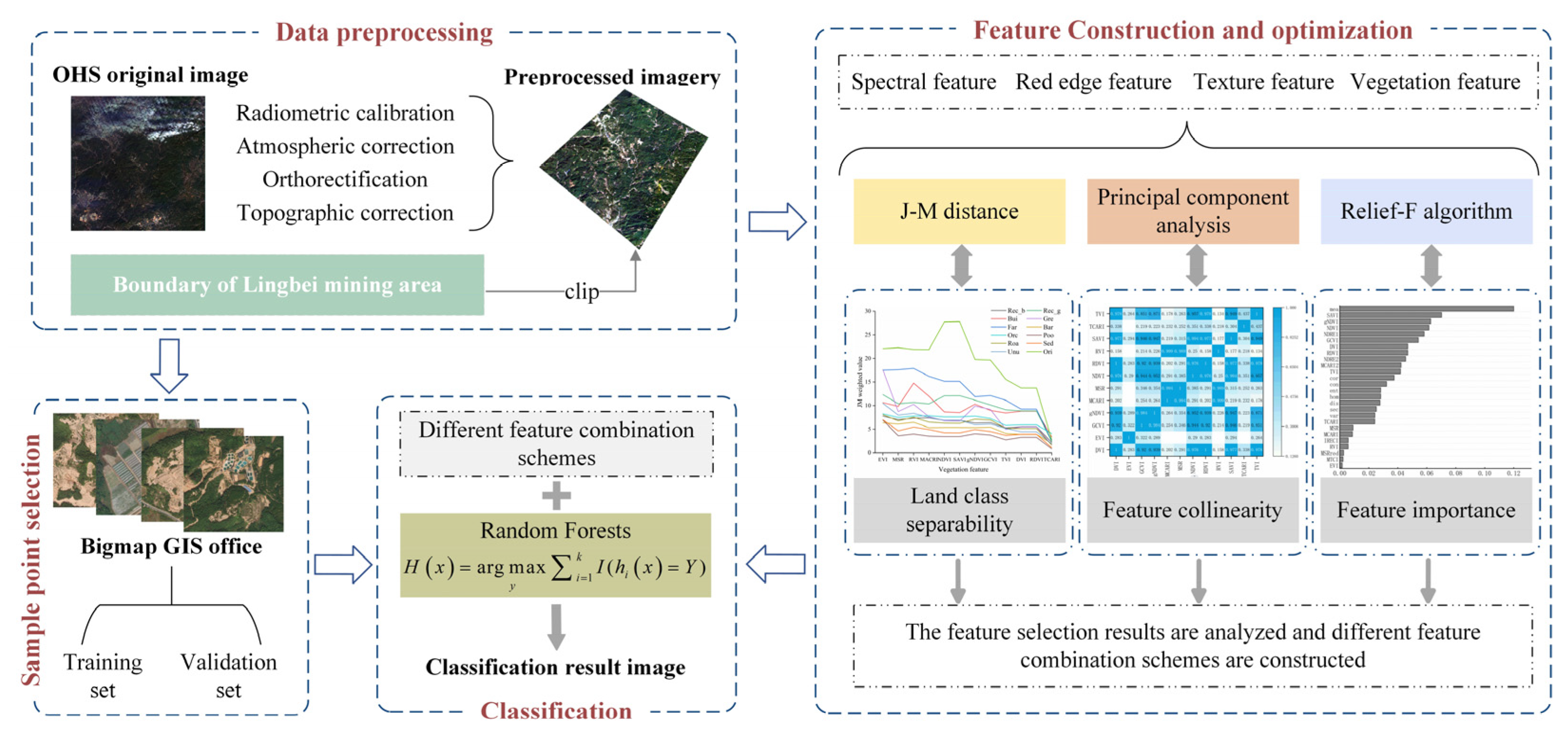
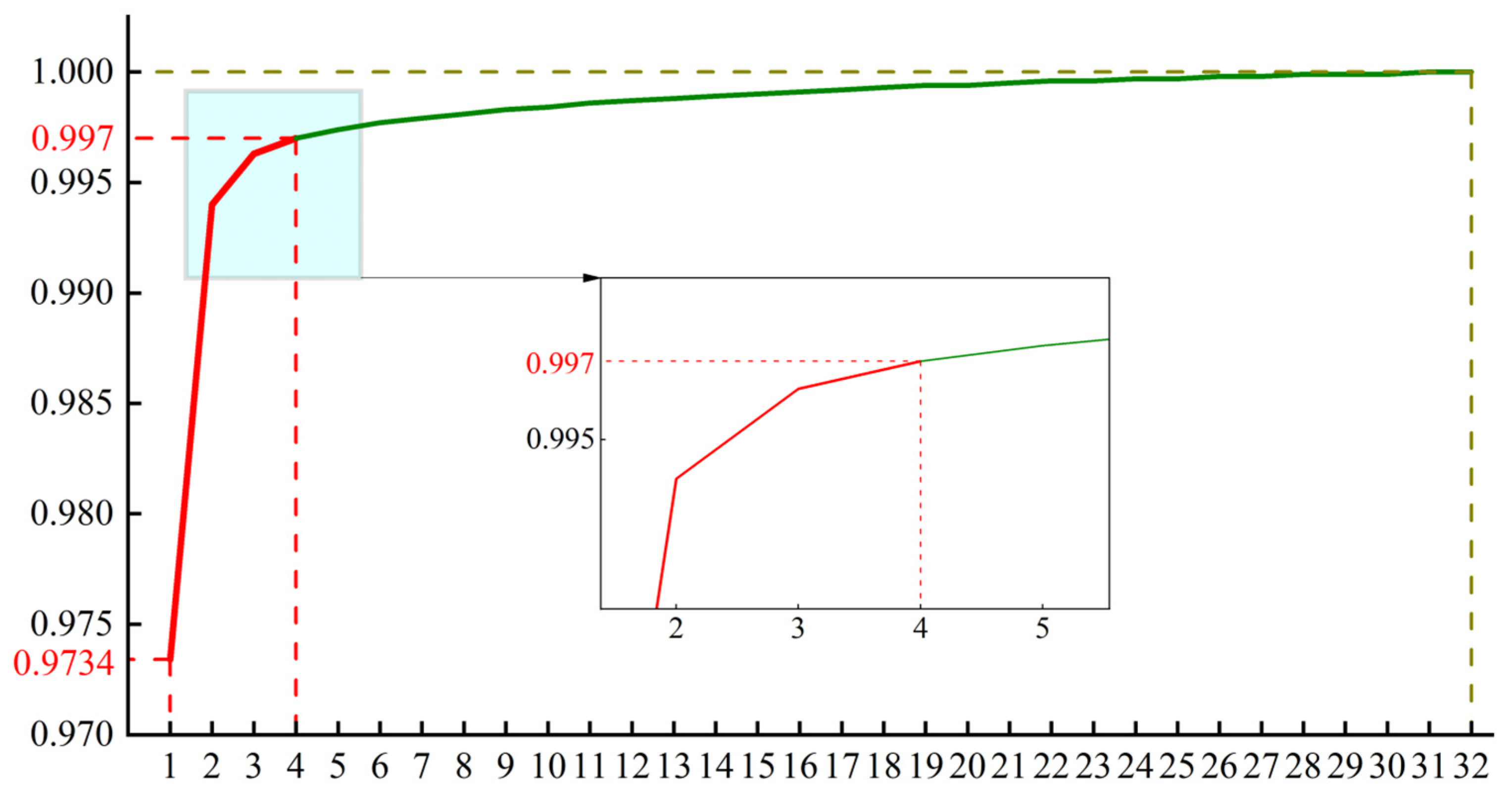
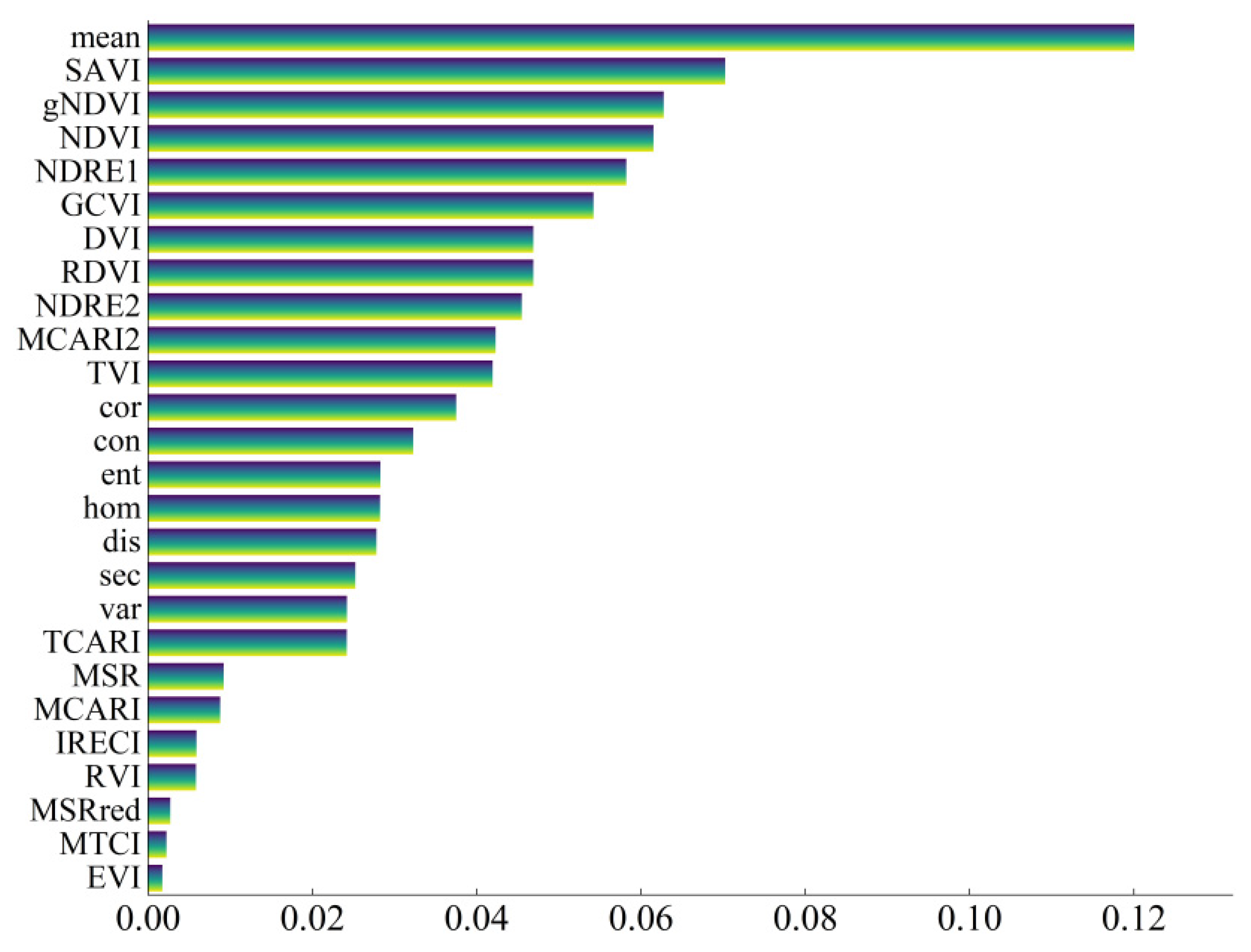
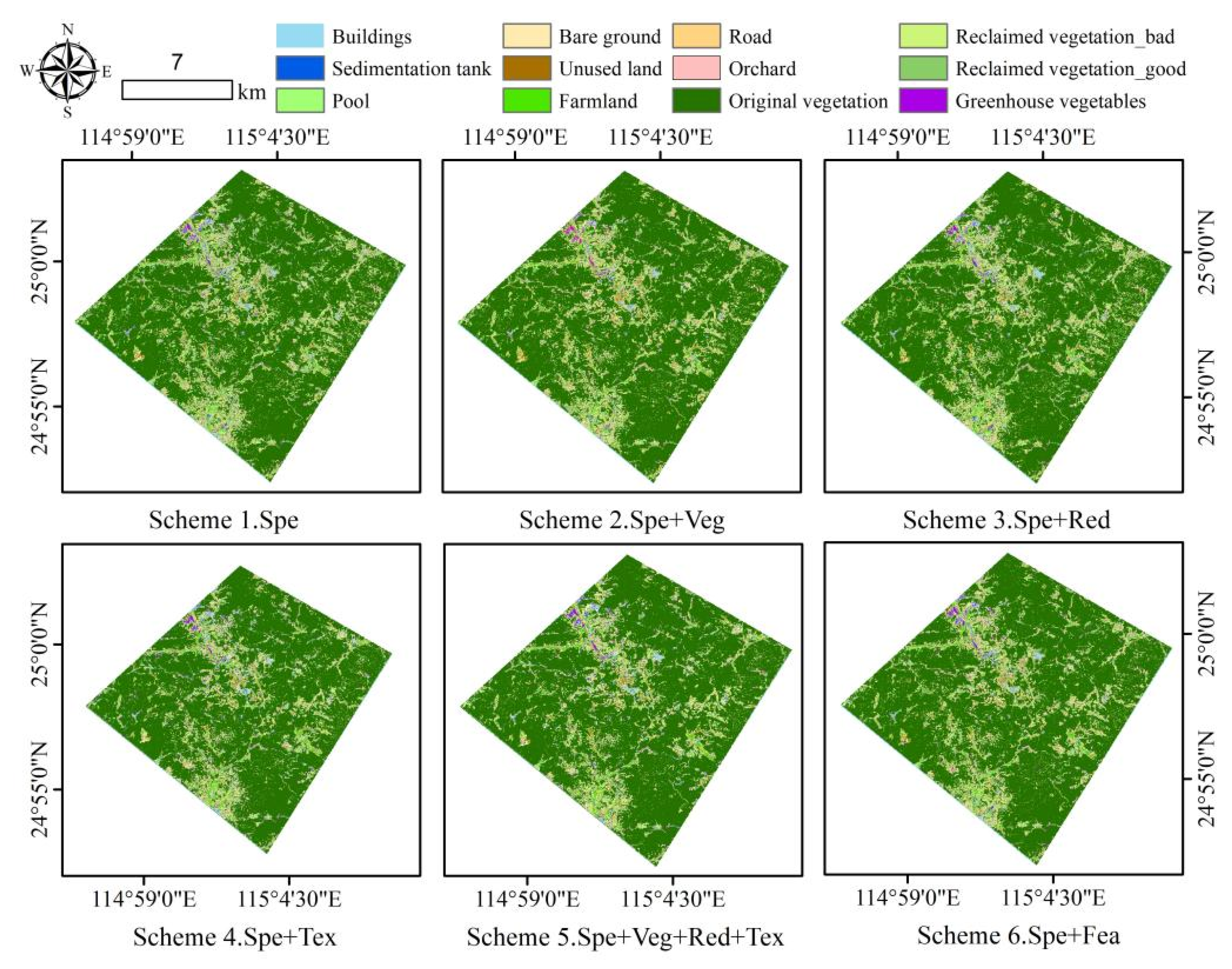


| Land Class | Explicit Explanation | Examples of Bigmap GIS Office | Examples of OHS Hyperspectral Imagery | |
|---|---|---|---|---|
| Artificial surface | Orchard (Ora) | The orchard is in the shape of a ladder with a distinct slope. |  |  |
| Pool (Poo) | Ponds usually have edges that are easier to identify. |  |  | |
| Road (Roa) | Roads are generally long and continuous. |  |  | |
| Building (Bui) | Buildings are usually rectangular and neatly arranged. |  |  | |
| Farmland (Far) | It is composed of a large number of irregularly shaped plots closely connected, with obvious features. |  |  | |
| Sedimentation tank (Sed) | They are generally round and rectangular in shape and are densely distributed within a given area of the mine. |  |  | |
| Greenhouse vegetables (Gre) | It usually occurs in spring and winter and is more neatly arranged by adding tops to farm fields. |  |  | |
| Natural surface | Unused land (Unu) | Mostly abandoned agricultural land, soils that are not planted with vegetation but show signs of cultivation, etc. |  |  |
| Original vevetation (Ori) | Undeforested primary forests exist in large continuous areas. |  |  | |
| Reclaimed vegetation_good (Rec_g) | The saplings are regularly arranged, with good average growth, and are planted in an overall rectangular shape in the reclaimed area. |  |  | |
| Reclaimed vegetation_bad (Rec_b) | There is no clear pattern of saplings in the reclaimed area and their growth is clearly uneven, with the surrounding ground more similar to bare ground. |  |  | |
| Bare ground (Bar) | Land without any cover or treatment on the surface, generally located in the vicinity of mining areas. |  |  |
| Feature Variable | Index Abbreviation | OHS Image Calculation Formula | Exponential Description |
|---|---|---|---|
| Spectral feature | Band | B1, B2, …, B32 | |
| Vegetation feature | GCVI | Suitable for areas with high density vegetation cover. | |
| RDVI | It can be used for high and low vegetation coverage. | ||
| TCARI | It is very sensitive to changes in chlorophyll content. | ||
| EVI | More sensitive to high vegetation coverage. | ||
| NDVI | Characterize vegetation coverage and growth and health status. | ||
| TVI | Affected by chlorophyll and leaf tissue abundance, the difference between vegetation was obvious. | ||
| SAVI | It contains soil regulation coefficient and is more suitable for low vegetation cover area. | ||
| MSR | The index is based on an assessment of several vegetation indices derived from a combination of two spectral bands. | ||
| RVI | It is used to estimate and measure vegetation biomass and is sensitive to high vegetation coverage. | ||
| gNDVI | There was significant correlation with chlorophyll content and leaf area index. | ||
| MACRI | It was responsive to chlorophyll concentration and background reflectance of leaves. | ||
| DVI | It is sensitive to the change in soil background, and the sensitivity to vegetation decreases when the vegetation coverage is high. | ||
| Red edge feature | NDRE1 | It can be used to estimate leaf area index and chlorophyll content of plants. | |
| NDRE2 | It can be used in fine agriculture, vegetation stress detection, and so on. | ||
| MSRred | Replace the near infrared band in MSR with a valley with a red edge. | ||
| MTCI | It is sensitive to chlorophyll content in plant leaves. | ||
| MCARI_red | It is more sensitive to the chlorophyll content in plants and the higher the value, the higher the chlorophyll content. | ||
| IRECI | It is correlated with chlorophyll content and leaf area index of plant canopy and can quantitatively characterize chlorophyll content of plant. | ||
| Texture feature | Mean | Calculated based on the first four principal component bands after the original spectral principal component analysis, using window size: 5 × 5. | |
| Variance(Var) | |||
| Homogeneity(Hom) | |||
| Contrast(Con) | |||
| Dissimilarity(Dis) | |||
| Entropy(Ent) | |||
| Second Moment(Sec) | |||
| Correlation(Cor) | |||
| Combination Scheme | Specific Feature Information of the Scheme |
|---|---|
| Scheme 1 | Spectral feature(Spe)(RF) |
| Scheme 2 | Spectral feature+Vegetation feature(Spe+Veg)(RF) |
| Scheme 3 | Spectral feature+Red edge feature(Spe+Red)(RF) |
| Scheme 4 | Spectral feature+Texture feature(Spe+Tex)(RF) |
| Scheme 5 | Spectral feature+Vegetation feature+Red edge feature+Texture feature(Spe+Veg+Red+Tex)(RF) |
| Scheme 6 | Spectral feature+Feature importance ranking combination(Spe+Fea)(RF) |
| Scheme 7 | Spectral feature+Vegetation feature+Red edge feature+Texture feature(Spe+Veg+Red+Tex)(SVM) |
| Land Assemblage | Weights | Land Assemblage | Weights | Land Assemblage | Weights |
|---|---|---|---|---|---|
| Rec_b, Far | 2 | Rec_g, Far | 3 | Gre, Roa | 2 |
| Rec_b, Rec_g | 4 | Far, Bar | 2 | Gre, Sed | 2 |
| Rec_b, Bar | 4 | Far, Ora | 3 | Bar, Ora | 2 |
| Rec_b, Ora | 2 | Far, Unu | 4 | Bar, Roa | 4 |
| Rec_b, Unu | 3 | Far, Ori | 2 | Bar, Unu | 3 |
| Rec_b, Ori | 2 | Rec_g, Bar | 2 | Ora, Unu | 2 |
| Bui, Gre | 4 | Rec_g, Ora | 3 | Ora, Ori | 2 |
| Bui, Roa | 2 | Rec_g, Unu | 2 | Poo, Sed | 3 |
| Bui, Sed | 2 | Rec_g, Ori | 4 | Roa, Sed | 2 |
| Unu, Ori | 2 |
| Classifications | Scheme 1 | Scheme 2 | Scheme 3 | Scheme 4 | Scheme 5 | Scheme 6 | Scheme 7 | |
|---|---|---|---|---|---|---|---|---|
| Overall Accuracy | 83.59% | 85.56% | 84.52% | 86.68% | 88.43% | 88.26% | 88.16% | |
| Kappa coefficient | 0.51 | 0.55 | 0.53 | 0.58 | 0.62 | 0.59 | 0.61 | |
| Buildings | PA% | 82.06 | 81.29 | 83.59 | 82.36 | 85.74 | 80.21 | 84.97 |
| UA% | 57.47 | 63.70 | 52.40 | 63.25 | 58.84 | 66.88 | 56.07 | |
| Sedimentation tank | PA% | 25.48 | 26.44 | 25.00 | 35.58 | 38.94 | 17.79 | 31.73 |
| UA% | 12.83 | 15.71 | 15.25 | 16.37 | 24.92 | 14.23 | 21.36 | |
| Pool | PA% | 82.82 | 86.50 | 68.71 | 74.85 | 61.96 | 68.71 | 67.48 |
| UA% | 13.53 | 15.06 | 13.49 | 17.40 | 21.40 | 14.18 | 22.40 | |
| Bare ground | PA% | 41.29 | 41.94 | 40.65 | 56.13 | 50.97 | 34.19 | 49.68 |
| UA% | 4.26 | 4.93 | 3.96 | 7.95 | 7.47 | 12.77 | 7.59 | |
| Farmland | PA% | 52.04 | 51.68 | 58.54 | 65.51 | 66.98 | 54.52 | 64.86 |
| UA% | 83.27 | 83.33 | 87.24 | 89.22 | 91.01 | 78.96 | 91.12 | |
| Road | PA% | 100.00 | 100.00 | 100.00 | 100.00 | 100.00 | 91.67 | 100.00 |
| UA% | 3.46 | 3.54 | 4.08 | 3.66 | 3.58 | 1.96 | 3.79 | |
| Orchard | PA% | 28.38 | 25.73 | 27.32 | 25.20 | 28.91 | 4.24 | 28.65 |
| UA% | 12.74 | 13.31 | 19.54 | 11.63 | 17.17 | 3.02 | 15.91 | |
| Original vevetation | PA% | 89.33 | 91.41 | 89.93 | 91.82 | 93.71 | 95.20 | 93.57 |
| UA% | 99.24 | 99.17 | 99.24 | 99.21 | 99.22 | 99.29 | 99.19 | |
| Reclaimed vegetation_good | PA% | 37.19 | 32.46 | 38.99 | 37.03 | 36.22 | 15.50 | 36.54 |
| UA% | 19.81 | 24.81 | 17.92 | 28.13 | 29.40 | 20.79 | 28.75 | |
| Reclaimed vegetation_bad | PA% | 27.45 | 27.12 | 33.99 | 29.41 | 32.03 | 24.35 | 30.72 |
| UA% | 24.21 | 25.74 | 33.66 | 30.20 | 36.57 | 22.11 | 36.22 | |
| Greenhouse vegetables | PA% | 50.90 | 61.44 | 52.33 | 60.68 | 61.16 | 60.11 | 60.78 |
| UA% | 70.81 | 73.69 | 70.73 | 66.91 | 74.62 | 72.01 | 70.25 | |
| Unused land | PA% | 50.00 | 55.71 | 55.71 | 67.14 | 62.86 | 85.71 | 67.14 |
| UA% | 12.46 | 10.66 | 13.88 | 16.97 | 14.47 | 12.55 | 15.31 | |
Disclaimer/Publisher’s Note: The statements, opinions and data contained in all publications are solely those of the individual author(s) and contributor(s) and not of MDPI and/or the editor(s). MDPI and/or the editor(s) disclaim responsibility for any injury to people or property resulting from any ideas, methods, instructions or products referred to in the content. |
© 2024 by the authors. Licensee MDPI, Basel, Switzerland. This article is an open access article distributed under the terms and conditions of the Creative Commons Attribution (CC BY) license (https://creativecommons.org/licenses/by/4.0/).
Share and Cite
Li, C.; Li, H.; Zhou, Y.; Wang, X. Detailed Land Use Classification in a Rare Earth Mining Area Using Hyperspectral Remote Sensing Data for Sustainable Agricultural Development. Sustainability 2024, 16, 3582. https://doi.org/10.3390/su16093582
Li C, Li H, Zhou Y, Wang X. Detailed Land Use Classification in a Rare Earth Mining Area Using Hyperspectral Remote Sensing Data for Sustainable Agricultural Development. Sustainability. 2024; 16(9):3582. https://doi.org/10.3390/su16093582
Chicago/Turabian StyleLi, Chige, Hengkai Li, Yanbing Zhou, and Xiuli Wang. 2024. "Detailed Land Use Classification in a Rare Earth Mining Area Using Hyperspectral Remote Sensing Data for Sustainable Agricultural Development" Sustainability 16, no. 9: 3582. https://doi.org/10.3390/su16093582






